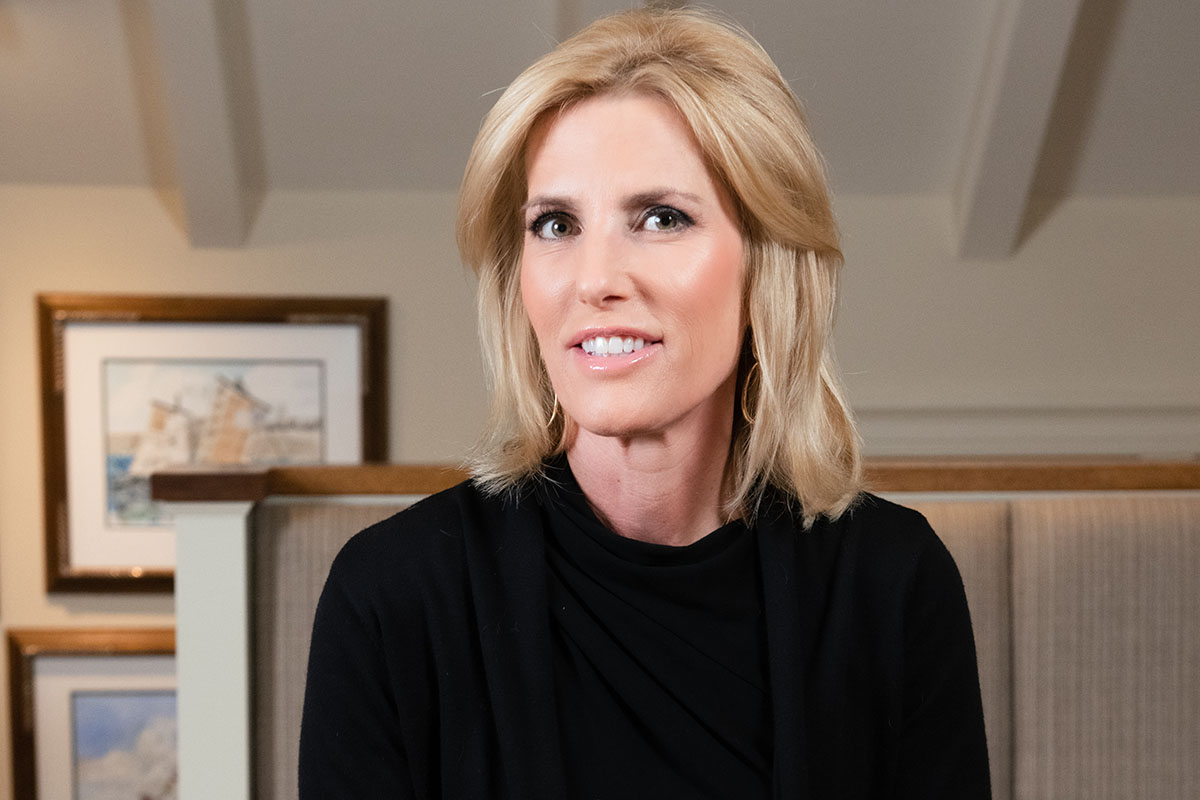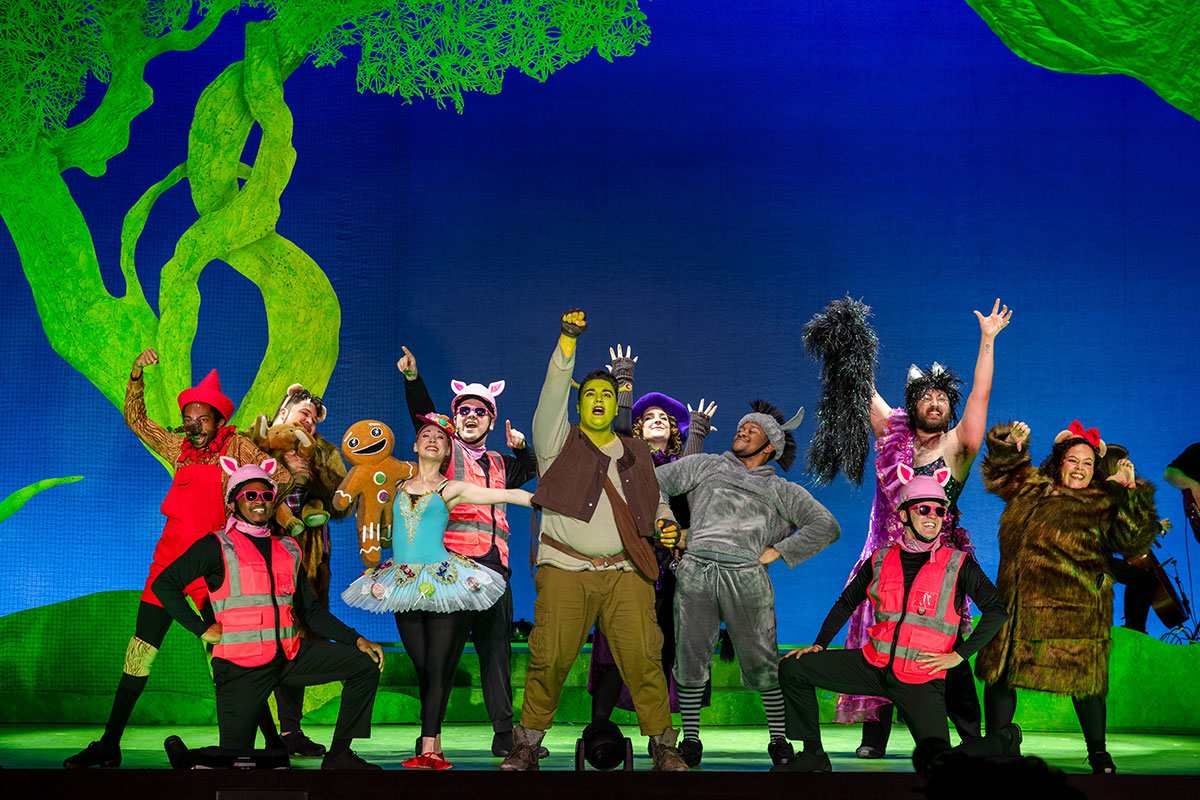On a recent November afternoon, as the sun was sinking behind the treetops, Laura Ingraham struck a pose in its dwindling rays. Standing in the doorway of a two-story suburban McLean home, she smiled confidently for the photographer clicking away at her.
Then she had an idea.
“Christmas cards!” she called out to her assistant and her hair stylist, both of whom stood watching a few feet away. “We should get the kids over here, while the light is still good.”
Ingraham went back to posing, and within a few minutes was joined by her three children, who could not have looked any more ready for the occasion if they’d had all day and a team of stylists to prep them. Nikolai, 11, and Dmitri, 13, wore touches of crimson—in the check of a shirt and the pattern of a tie, respectively—as each tentatively took a stance on either side of Maria, 16, youthful but glamorous in a black puff-sleeve dress and white sneakers. Their mother stepped between them and the wreath-bedecked front door, and voilà: It was family picture time.
After a minute or so, Ingraham leaped out of the frame and watched while her kids went on smiling for the camera. “You’re posing,” she called out at one point. “Relax, Niko, relax.” Finally, clapping her hands, Ingraham recognized when everyone had had enough. “You guys look awesome.” She laughed as she turned to her assistant and her makeup artist. “Won’t he be surprised when he gets this card in the mail? He’ll be like, ‘That’s my house!’”
By “he,” she’s referring to her friend, who lent his home for the occasion. Which would likely be news to everyone else who went on to open that card in December. Addressed from Laura Ingraham, with her face and those of her three children in front of a stately but cozy-looking manse, the Christmas card would give off from-our-family-to-yours warm wishes. So some card recipients might find it a little surprising—strange, even—to learn this is not even Ingraham’s home.
The controversial Fox News host, 58, does live nearby, maybe in a house very much like this one. Or maybe not. She gets too many death threats to be able to pose in front of her own front door for Christmas-card photos anymore, or even share her Northern Virginia address. She has to borrow a friend’s house for moments like these—even something personal, like a Christmas-card photo, which is, yes, a little strange.
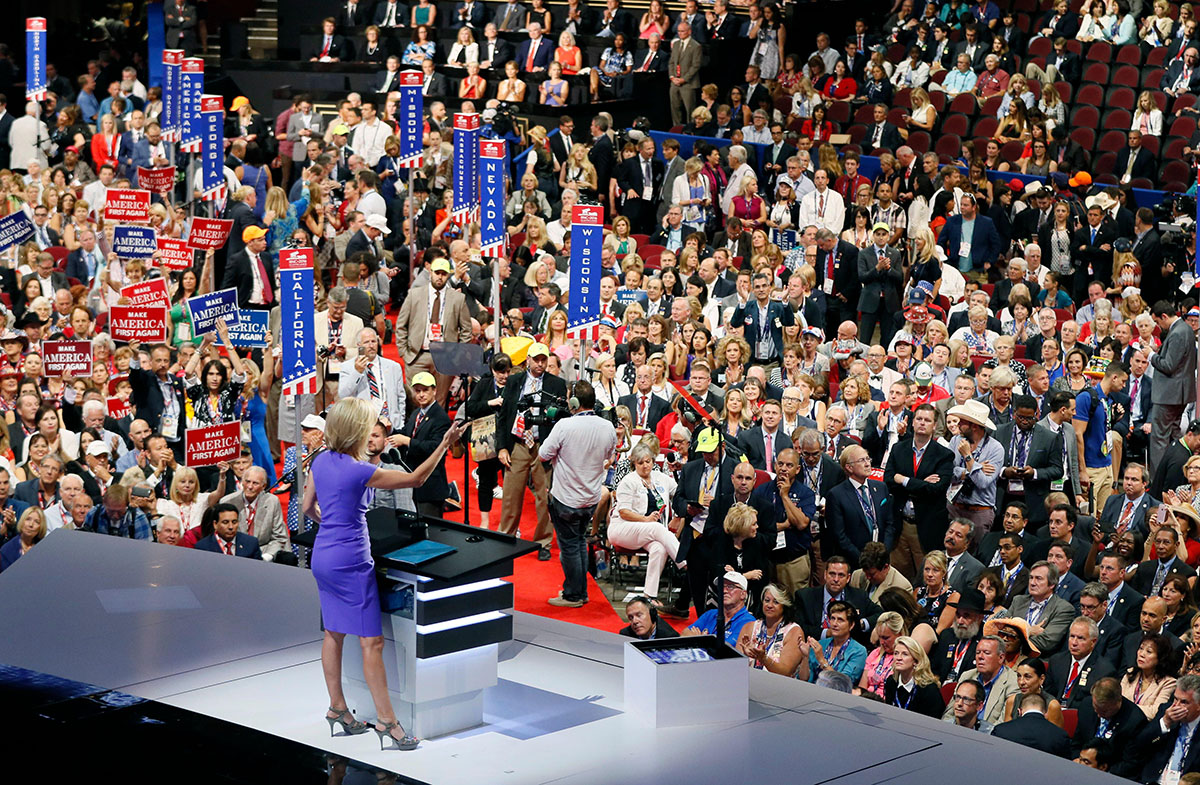
It’s Still Her Moment
Ingraham’s children, all of whom she adopted from abroad, are among an exclusive group of people whose opinions matter to Ingraham. In fact, the handful of people gathered there that day are among the few voices that Ingraham claims to listen to. “Close friends, who are really good grounding influences on me,” she says. “They’ll say, ‘You know, you might want to phrase that differently,’ or, ‘That could be misinterpreted.’ I stop and think about that.”
You would be forgiven for thinking it hasn’t stopped her from saying much.
Just a few of her TV show The Ingraham Angle’s greatest hits, in terms of the shock and outrage they drew, might include that time she referred to illegal-immigration detention centers as “essentially summer camps”; telling LeBron James he should quit talking politics and “shut up and dribble”; or mocking a Parkland shooting survivor over college rejections (that one prompted an advertiser backlash and an apology from Ingraham). And yet none of that has stopped her from rising to the top of the cable news battle. On a typical weeknight, her 10 p.m. program draws 3.07 million viewers, making her cable news’ highest-rated solo female host, according to the latest Nielsen numbers. This past Election Day, with the nation’s eyes on Virginia as it chose Glenn Youngkin for its governor, that number rocketed to 5.14 million, topping the hour’s numbers from CNN (1.23 million) and MSNBC (1.55 million, on average, from 8 p.m. to 11 p.m.) put together.
The morning after that highly charged election night, Ingraham is in a hurry to get to our Zoom interview. Settling in for our call, she apologizes for her “beleaguered-mother appearance.” It’s not quite 11:30, and she’d already been to a school meeting that morning. But the previous evening’s election results seem to buoy her, even on the three hours of sleep she’s gotten.
“I’m heartened,” she says. “I’m pretty optimistic about the country.”
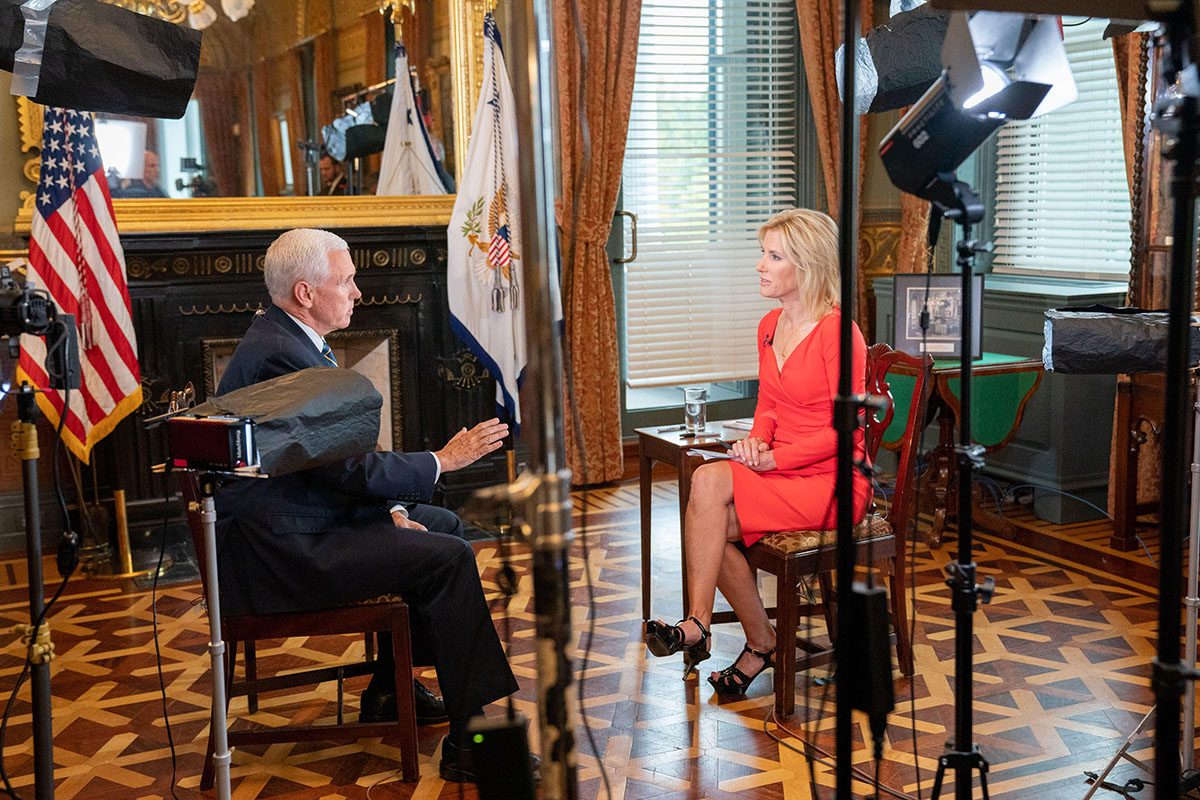
The results reflect a starkly different political mood across the country compared to 2020. “A lot of conservatives were feeling a year ago, you know, completely dejected,” she says. “I kept saying, ‘I’ve been around for 30 years, doing this in one form or another. There’s always another election, so don’t get too dragged down by the results of one.’”
Keeping an eye on the long view is something Ingraham knows a little about—and no matter what side of the aisle you’re on, it might be a good idea to heed her predictions. She was among the first commentators, even on Fox News, to champion Donald Trump in his 2016 presidential campaign, sticking by his side even as fellow conservative pundits roundly laughed him off in those early days. Trump, Ingraham maintained, had tapped into a certain mood that much of the country was feeling, and shouldn’t be counted out too soon: not then, and not now.
“I’m not saying I’m there for him yet,” Ingraham says, when asked if she’ll support him in 2024. “But I think whether he runs or not—I mean, his policies worked. Trump’s blueprint for policy—a forward-looking, optimistic set of pro-America policies—that blueprint, without a doubt, is winning.” The use of the word “winning,” a Trump-like framing, is perhaps not mere coincidence—it’s not the only quality she shares with the ex-president, an old friend, someone she’d even reportedly gone on a date with back in the day. (It was just lunch, says Ingraham, and there were three people at the table, so it wasn’t really a date-date). And just as “the Donald” continues to hold sway over his party, even away from the White House, Ingraham’s hold on her conservative audience seems stronger than ever.
Ingraham Was Born for This
Like Trump, Ingraham, too, has never been afraid of verbal sparring—she’s the first to admit she enjoys debate. “I’m good at it,” she says. “I’ve been doing it since I was a kid because I have three older brothers.”’
Ingraham grew up in Glastonbury, a Connecticut suburb, as one of four kids in a working-class family. In conversation, she makes frequent references to her mother, Anne Ingraham, a waitress who instilled in her children morals that the TV host still holds dear. “If we wanted anything extra, we had to work for it,” says Laura’s oldest brother, Jim, now an engineer who lives in Santa Barbara, California. “[Mom] wasn’t able to go anywhere beyond high school, but we were all going to college. She was going to make sure that we did our homework and valued things that we got. So I think that work ethic is deep and in all of us.” For Laura, it’s a work ethic that found a home in competitive sports—she was always more athletic than her three brothers, Jim says.
“I dare you to try to hit a softball she throws, probably even today,” he says with a laugh. “She’s all about the sports.”
You can see that competitive spirit, in turn, in her rapid ascent. After graduating from Dartmouth, she landed a job as a speechwriter in the Reagan White House, earned a law degree at the University of Virginia in 1991, went on to clerk at the Supreme Court for Clarence Thomas, then worked at global firm Skadden Arps in corporate criminal defense. But her aspirations were always to be a performer.
“I kept on watching stuff on television and thinking, I can do better than that,” she told UVA law students in a speech there in 2013.
Ingraham got her own radio program in 2001, one year after publishing her first book, The Hillary Trap. She became the queen of conservative talk radio, with her Laura Ingraham Show listened to in 230 markets, and began popping up on TV with some regularity as a political talking head.
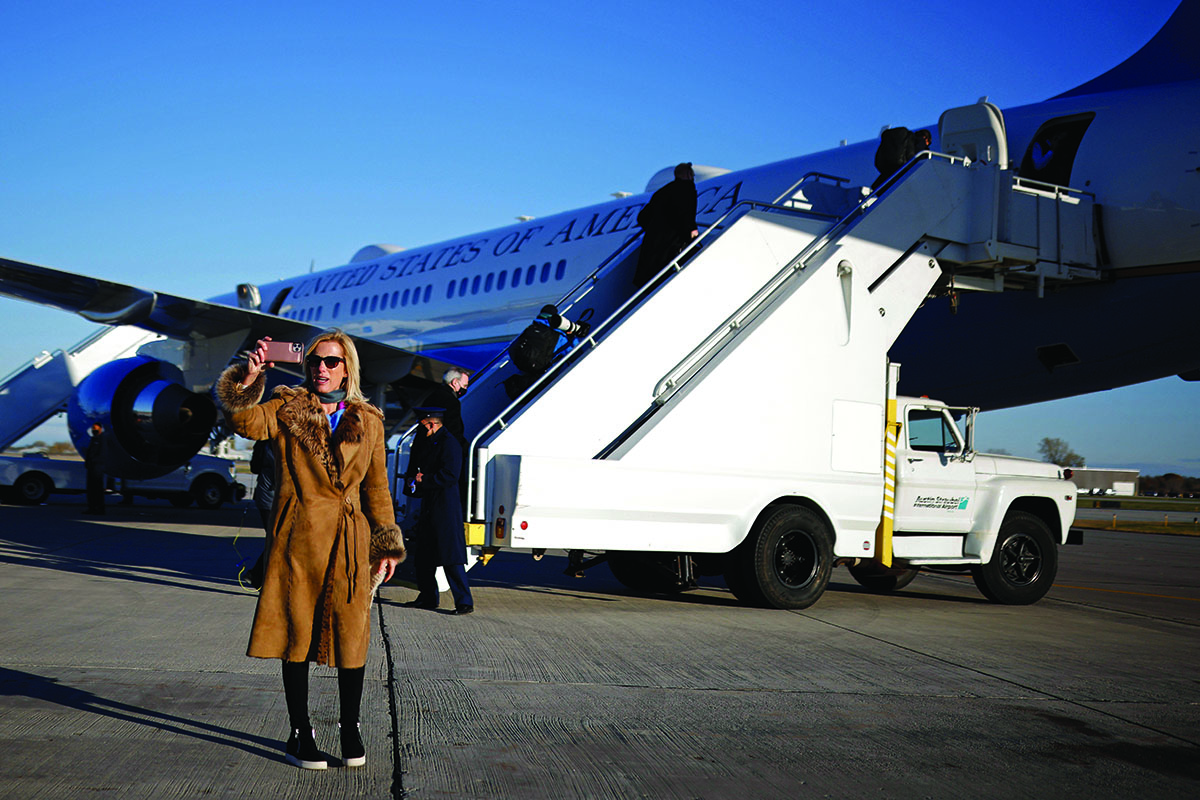
Ultimately, Ingraham’s media canny about Trump’s political savvy may have contributed to landing her own TV show in the coveted 10 p.m. slot on Fox News in 2017. And it wasn’t long before she was courting serious controversy. In early 2018, she mocked a Parkland shooting survivor, David Hogg, over the colleges he’d gotten rejected from. Within 24 hours, multiple advertisers announced they’d be yanking their spots from Ingraham’s show. “On reflection, in the spirit of Holy Week, I apologize for any upset or hurt my tweet caused him or any of the brave victims of Parkland,” she tweeted.
Later that year, when much of the world was reeling in horror over the Trump administration’s illegal-immigrant detention centers—the ones that looked an awful lot like cages to a lot of people—Ingraham defended the facilities as “essentially summer camps.” The online backlash was swift enough that even by the end of her program that night, Ingraham backtracked a bit, saying she would instead stick with the San Diego Union-Tribune’s characterization: “boarding schools.”
But perhaps her most memorable remark of that year came after LeBron James gave CNN a politically charged interview criticizing Trump; she dismissed his comments as “barely intelligible” and “ungrammatical,” and said he should quit talking politics and “shut up and dribble.” This last shot reverberated through the zeitgeist, inspiring the name of James’s Showtime series about the role of Black athletes that aired later that year. Many were quick to point out hypocrisy on Ingraham’s part when, in 2020, she defended quarterback Drew Brees’s right to talk politics.
Taking a Controversial Stance
And yet, despite the fact that she and Trump both share a reputation for making the discourse volatile, to say the least, Ingraham claims to represent a more reasonable point of view than standard political back-and-forth.
“Most people don’t live in that headspace,” Ingraham says. “Most people want a better living for their kids. They want to have a vacation every year for two weeks, maybe, and relax. And they don’t mind the Pledge of Allegiance. They don’t viscerally react negatively to ‘The Star-Spangled Banner.’ I mean, they were fine with Columbus Day.”
Her show is better, she says, when multiple points of view are featured, and she has bemoaned the “partisan tenor” of Washington in interviews. Things have gotten overheated, she says. “That’s made having the conversation with an opposing guest maybe more difficult, but it shouldn’t be that way.”
In defense of her own partisanship, she points to the pragmatics of cable television.
“I’m an opinion show. I’m not a point-counterpoint show,” she says, adding, “we invite Democrats on the show all the time. It’s a challenge to get them to come on.” She acknowledges, however, that her issue with opposing figures runs deeper than that.
“Here’s the problem,” she says. “When your political opposition refers to you as racist every time you disagree with them, I’m not anxious to be featuring that on the show … That’s not an enlightened conversation.”
Ingraham preferred talking to what she calls the “true liberals” she used to frequently spar with on her radio show, like writers Christopher Hitchens and Nat Hentoff and movie director Paul Mazursky. “We had great conversations,” she says. “The old-style Democrats understood it a little bit better. I think Democrats have become the new Puritans. They’re the puritanical thinkers out there, because they think, You either agree with us on this, or you’re a horrible racist or you’re a misogynist or you’re KKK. And we’re basically like, ‘No, we actually think there are multiple points of view on this’ … We actually have a range of views in the Republican party which I think are, frankly, a lot more open-minded on things than the Democrats right now.”
That puritanical approach is, in her view, what’s sinking the Democratic party.
And yet her own means of expression have drawn fierce criticism. Back in 2008, she was already dubbed “right-wing radio’s high priestess of hate” by Rory O’Connor, author of Shock Jocks: Hate Speech and Talk Radio. One of her older brothers, Curtis, has publicly disavowed her for years, calling her “pathetic” and “a monster.” And that’s not even touching the muck that churns in online comment sections for almost any public figure, let alone a woman with a history of controversial right-wing commentary.
So does any of it ever get to her?
“I mean, No. 1, honestly, I don’t read it,” she says. “But No. 2, I’m kind of over the age to care. Look, I’m a middle-aged person. And I’m in a job where controversy is just part of the daily routine. You’re always going to offend somebody. And you’re always going to be a lightning rod on some issue. There’s never going to be 100 percent agreement on anything, and with social media being what it is, I mean, it’s just par for the course.”
You may love Laura Ingraham. You may think she’s everything that’s wrong with America in 2022. But you don’t know her.
“People have a preconceived notion of who I am,” she says. “And I don’t complain. It’s just a fact of life that because people know me from my old radio days or television, they think, She’s super controversial, or, She’s super hardcore. But politics is really a small part of who you are.”
For her, she says, all that stuff—the media career, the best-selling books, the high-profile speaking gigs at places like the Republican National Convention—is just a living.
“And I’m still the same person I always was, which is, I’m an avid athlete. I’m outdoorsy. I love animals. I love my kids. Most of the day I just spend laughing at myself or my kids because you know, we’re just fumbling through all this like everybody else.”
And even though she does gets recognized and approached a lot, most interactions with people who come up to her are pretty positive, she says.
“Occasionally, people who probably are not the biggest fans, to say the least, will whisper or take a photo of me, and I’m sure it ends up on some horrible site,” she says. “But I’ve never really cared what people write about me—or not for a long, long time, at least. I’ve never even Googled myself. People don’t believe me, but I just don’t care.”
This story originally ran in our January issue. For more stories like this, subscribe to our monthly magazine.

